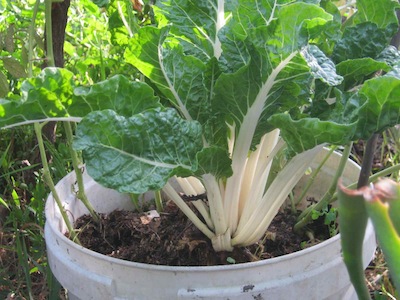Growing chard for year round healthy greens
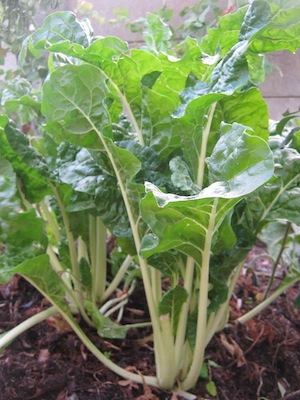 Growing chard is not demanding. Water and compost suffices
Growing chard is not demanding. Water and compost sufficesGrowing chard does not need special tricks or gardening acumen. It is definitely an easy vegetable to grow, and gives a high yield of fresh green leaves for a long time if you harvest cautiously.
Growing chard is simple
Its best to sow chard in the mild between-seasons, in our Cape climate. Avoid early to mid winter, May to July, when it is too cold and the seed does not come up, and the growth of seedlings is static. Sowing in December and January are also not recommended. February is our hottest month and planting out at this time is going to lessen the chance of survival. I have to test all the claims of other growers on the net and in books, so I sowed chard in May myself, and got no results, when it is normally so easy, so the planting calendar is at least partially confirmed by experience. I do know that you can harvest chard all year though.
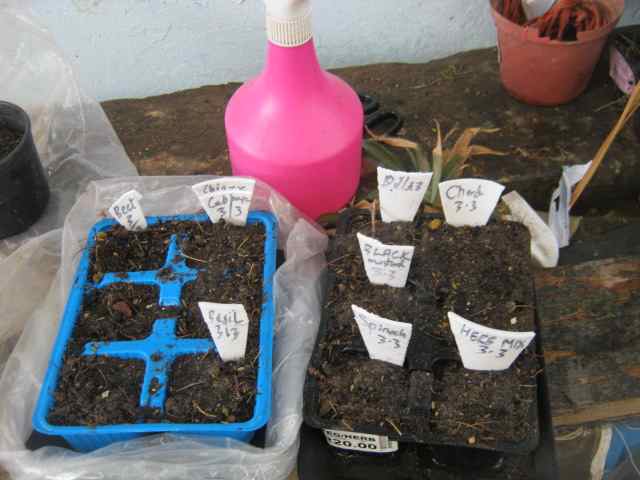 Sow chard in the in-between seasons, autumn and spring
Sow chard in the in-between seasons, autumn and springSow chard seeds in pre dampened seed trays, and cover with about 4mm of fine material. Press gently and water in with a soft sprinkler. The seeds germinate well under plastic, but the plastic bag must be removed as soon as they germinate, or they get too spindly. Alternatively you can just keep the soil moist by sprinkling daily.
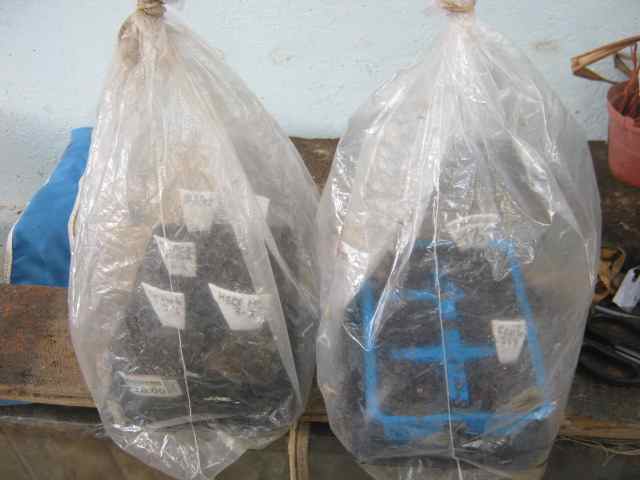
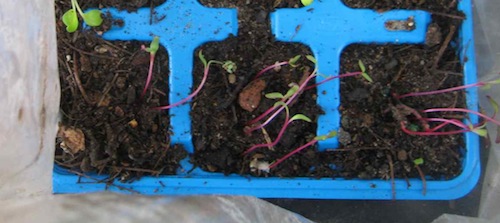 This chard stayed too long in plastic, but can be saved
This chard stayed too long in plastic, but can be savedOur soil seems to be ideal for many leaf vegetables. It is deep low nutrient sand, and the natural vegetation is acid loving, low nutrient lowlands Fynbos, or the more lime tolerant Strandveld (Beach vegetation). This may sound a bit hopeless for vegetables but with a lot of organic matter in the soil, and the black crusty crumbs of old worm composting beds all over the garden as well as mushrooms that come up everywhere, leaf vegetables as well as lighter feeders like tomatoes do well. There is always a danger of dryness and I mulch deeply with compost and keep the ground covered with plants. Both these are water-wise gardening techniques which you can also use for wilting-prone leaf vegetables. You can also plant chard in buckets where it will do very well.
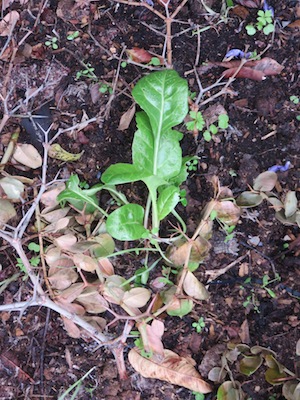 thorns protect young chard thorns protect young chard |
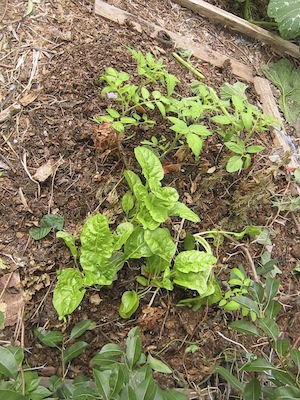 chard, tomatoes and basil chard, tomatoes and basil |
At the earliest when your seedlings have four adult leaves, but preferably a little later when they are a bit larger, plant them out gently without disturbing the roots in a pre-wetted hole, and gently close the soil around them and mulch in the vicinity. In our garden I also surround new plants with a spiky barrier of thorns. If I don’t do this I will find them lying roots up the next day, as the local thrushes all know our planting media are full of worms and they are on the lookout for new plantings, fresh compost and disturbed soil.
Allow the plants to get large enough before harvesting as leaf removal is the removal of the plant’s food production surface area, so you only want to take a small share at a time. Let’s wait, say, till thay have at least 8 large leaves before harvesting.
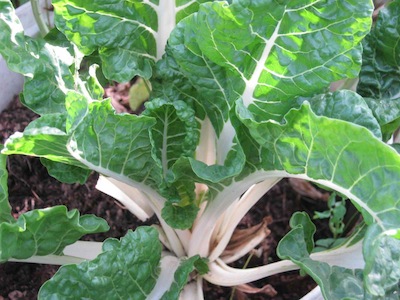 the harvested stumps on this chard plant are too long
the harvested stumps on this chard plant are too longTo harvest you can pluck 2 leaves at a time off each large adult plant and it will keep them going for a while. Taking too many leaves at once will set them back. Harvest preferably from the outside inward. My permaculture teacher also advocated removing all wilted leaves. Break or preferably cut them at the stem. Remnants of dead material on the plant look messy and also allow molds and other pathogens to enter the plant via its veins.
That is it then. With a half dozen plants you will have a nice portion of organic greens for the kitchen for a two person household. Green vegetables without agro chemicals are the basis of a healthy diet.
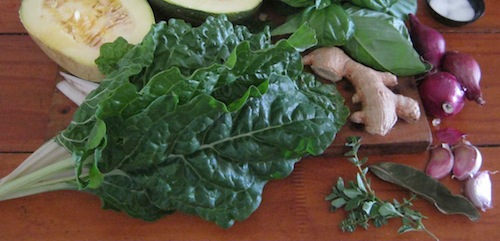 from garden to table for a green soup
from garden to table for a green soupGrowing chard helps you stay healthy
There are many ways to cook chard and I suggest you visit my husband’s food blog for ideas, like this traditional German dish with chard, potato and eggs. Chard is called Mangold in German. It is a part of the enormous range of leaf vegetables eaten in that country. You will see, or you used to see it for sale on the town square on Saturday mornings in German villages. That is where I learned about Ärpelslot. Toss still warm baby potatoes with Pflucksalat and oily vinaigrette. It’s one of those simple-but-sublime salads. Find out how to grow lettuce here and harvest the leaves very young for a similar taste experience.
------
home page for lots of tips on natural gardening
------
vegetable gardening the low cost natural way, with a list of the easiest vegetables
------
Restore Nature Newsletter
I've been writing for four years now and I would love to hear from you
Please let me know if you have any questions, comments or stories to share on gardening, permaculture, regenerative agriculture, food forests, natural gardening, do nothing gardening, observations about pests and diseases, foraging, dealing with and using weeds constructively, composting and going offgrid.
You’re a home gardener ! Share your experiences and questions !
We all know about home gardening. Tell us about your successes, challenges and ask about issues that bother you. You may have the luxury of a back garden, but there are other ways we learn. Few people age without growing something or buying vegetables during their lives ! It is absolutely guaranteed that you have learned things which can help others on their gardening journey.
We invite you to share your stories, ask questions, because if a thing has bothered you it will bother others too. Someone may have a solution ! No question is too small. There is learning for everyone involved, for you, for me (yes, I learn from every question), for us all. Exciting stuff !
We are starting on a new journey. Every week we will profile your letters ! The best stories and questions we receive.
SEARCH
Order the Kindle E-book for the SPECIAL PRICE of only
Prices valid till 30.09.2023
Recent Articles
-
Rose
Dec 17, 23 04:08 AM
I am doing research on growing wildlife foraging plants to use in enhancement plantings with wildlife in mind. My thoughts after seeing bears too skinny -
Seeds for a bred Sweeter less acidic Kei apple
Nov 20, 23 03:24 AM
Greetings Greenidiom, I'm a small farmer in kenya. I'm looking to plant a Green fence around a 6 acre plot of land and, I'd wish to make it of kei apples -
Mrs Laura Robinson
Oct 08, 23 02:17 AM
How do I get a copy of the soil aggregation poster??
"How to start a profitable worm business on a shoestring budget
Order a printed copy from "Amazon" at the SPECIAL PRICE of only
or a digital version from the "Kindle" store at the SPECIAL PRICE of only
Prices valid till 30.09.2023
